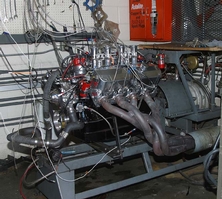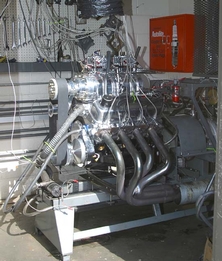Dyno Confusion FINALLY Cleared Up
 Q: It is confusing to the layman. I was a dealership mech. for about 28 years. I just bought two cars from a shop in Ohio. He said one was “450-500”. I had it Dyno’d Wed this week. It was 290.4 (RW) 310 torq.(rear wheels). They had a car show in this small town today, I blew two Vett’s in the weeds, with 290 HP. I don’t understand, this is all confusing. I have decided a long time ago, if you have 900 HP, but you only get 300 to the ground—-, then you have a 300 HP. Please let me know your thoughts.
Q: It is confusing to the layman. I was a dealership mech. for about 28 years. I just bought two cars from a shop in Ohio. He said one was “450-500”. I had it Dyno’d Wed this week. It was 290.4 (RW) 310 torq.(rear wheels). They had a car show in this small town today, I blew two Vett’s in the weeds, with 290 HP. I don’t understand, this is all confusing. I have decided a long time ago, if you have 900 HP, but you only get 300 to the ground—-, then you have a 300 HP. Please let me know your thoughts.
It all depends on the dyno and how it is reading and computing the power / load ratings. There are “inertia” dyno’s that give a particular number, and there are “load” dyno’s that give an entirely different number. Why do they do this you ask? If you took a typical DynoJet dyno (chassis dyno) and ran a car on it, it would give you a given number based on inertia and the spool-up speed of the drums. If you took that same car and put it on a Mustang Dyno or SuperFlow “load” dyno, you would get a much lower number simply because they are measuring power under different circumstances (under a load).
There is typically a 140 or so HP difference between an inertia dyno and a load dyno. Then you have to take that number and divide it by .85 to get the close approximation of power at the flywheel. Now, some people will argue about the .85 number and say you just need to figure on about a 60HP loss through any typical chassis, so you simply take the rear wheel power number and add about 60 to it and you’ll be in the ball park, but most dyno shops will tell you it is an average of 15% -%&aymp;nsp;loss through the chassis (on average). Well, .88 to .85 IS 15% -% w you are doing the math.
So let’s say you have a 450BHP engine (at the flywheel), that would be about the same as 380 RWHP on an inertia chassis dyno. You typically lose about 15% -% tugh the chassis, so 380 divided by .85 = 447HP at the flywheel (basically 450HP). Now, with a “load” chassis dyno, you will typically have about 140 LESS power than you would with a “non-load” (inertia) type of dyno. So take that 380 at the rear wheel and drop that down by 140HP, which comes out to 240 RWHP under a load. So, 240HP under a load 140 variation HP = 380 basic RWHP, now divide that by .85% ayou get approximately 447HP at the flywheel.
Your car made 290 RWHP and you blew the doors off of two new Vette’s which are quite powerful cars and run fairly easy 12 second quarter mile times. 290 HP isn’t enough to run 12’s in the quarter mile, not even with a hurrican for a tail wind, so I have to assume that your 290HP was a “loaded” HP reading. If it wasn’t a loaded reading, then your engine was only making 341 Flywheel HP (BHP) and that just isn’t a number that is very capable of blowing the doors off of two new Vettes, so it had to be a loaded number.
So, 290 RWHP under a load, plus the 140 variation you normally have between inertia dynos and load dynos = 430 non loaded RWHP. Take that and divide it by .85 and you are making in the neighborhood of 505 BHP (at the flywheel).
Just for the sake of argument, some people say to only add 60 HP to make-up for the loss through the chassis. OK, then you take your 430 non loaded RWHP and ad 60 more to it to compensate for chassis loss and you come out to 490 BHP. That is pretty damn close to the number you get when you divide by .85. Which one is more accurate? Honestly? I don’t know, (and couldn’t know), unless we first dyno’d the engine and then stuck the engine into the car (making NO tuning changes or modifications) and running it on the chassis dyno and seeing what we got as far as a difference between the engine itself and the loss through the chassis.
The bottom line here is simple. You certainly can’t blow the doors off of two Vettes with 290 RWHP unless the two guy’s in the other cars didn’t know you were racing them.

While we’re at it, let me explain something about engine dynos. People say dynos don’t lie. Well, they don’t… but the people entering the aquisition data DO, and if they fudge the numbers here or there (barametric pressure, relative humidity, air density, air temperature, the amount of water being fed to the water brake, etc.) then the dyno can only compute what it is told to compute. So in reality, no… the dyno won’t lie, but it will give bogus readings if the data isn’t accurately fed into the machine.
Let me tell you a quick little story. I got this call from a potential new customer. He runs a car on the open track and it’s a 383 Chevy with mildly ported iron heads. He said it dyno’d at 538HP with 9:1 compression and ran on 91 octane fuel. I said that was hard to believe so he sent me his dyno sheets and sure enough, it said 538HP BUT when I looked at the atmospheric pressure reading, it was at 20psi!!!
Let me explain something; on any given day, we have 14.7 psi of atmospheric pressure. Engines don’t actually “suck-in” fuel and air. It is actually blown-in by the amount of atmospheric pressure we have around us. Just like you don’t get sucked out of an airplane if the fuselodge gets a hole ripped in it. You get blown out. There’s no vacuum in the air at 35,000 feet! There might be a vacuum in space but planes don’t fly in outer space, they fly INSIDE out atmosphere. The presure is very low way up there (because there’s no air), so to protect your ears (and so you can breathe) they pressurize the cabins with air pressure and oxygen. Well, if a window pops out of the plane, all of the air (about 8psi worth) all wants to go out, and it “blows you out” with it.
OK, back to engines. So the atmospheric pressure actually blows air into the engine. If you increase the atmospheric reading on the dyno, it will calculate (correct) the power number to make-up for the data that you fed into the data acquisition system. This system is sometimes called a “D-Pack”
Now let me tell you a quick little tid bit about blowers so you’ll understand whet the hell I’m talking about. Blowers INCREASE the amount of pressure being forced into an engine. If you have a 350 cubic inch engine and you ADD 14.7 psi of blower boost, you just DOUBLED the cubic inch displacement of that engine by 100% simply because you doubled the atmospheric pressure. Now that 350 cubic inch engine has 700 cubic inches of “volume” inside making the power. Well, it’s pretty easy for a 700 cubic inch engine to make 700 HP, just as it is easy for a 350 cubic inch engine with 15 psi of blower boost to make 700 HP. It’s all the same thing, just done different ways. Cubic inches are cubic inches, pressure is pressure, and… pressure (or FLOW rather) makes volume!
Anyway, my point here is; the atmospheric pressure reading on this guy’s dyno sheet was at 20psi. Well that is equal to having a blower on that engine forcing more than 5 psi of blower boost into it! Figure an average, well built 383 engine with 200 cc heads and a cam profile like this guy had (which was fairly radical), that engine would have surely made an easy 435 – 440 HP. Now add that 5.3 psi of boost and it would have easily tipped the dyno at about 535 – 540 or so HP. How do I know that you ask? Because on any “typical” performance engine, you get “about” 18 – 20 HP per pound of blower boost, so 5.3 psi of added boost into that engine comes out to an extra 95 -105 HP ON TOP of what it was actually making. So let’s say he had 425 HP. Now add the equalivelancy of 5.3 psi of blower boost (95 – 105 HP) and you end-up with 535 – 540 HP, which is exactly what his dyno sheets said he was making. Go figure…. This ain’t my first rodeo 🙂
So, the dyno didn’t actually lie but the data fed into the machine certainly did. This is how magazine articles inflate numbers on dyno’s, how cheapie engine can look good on the dyno and how you can “fudge the numbers” on a dyno to make it look like the engine makes more power than it actually does.
Now for DeskTop Dynos. You can calculate just about anything with math. All Desk Top Dyno’s do is crunch numbers. What they don’t do is take into consideration things like “velocity”, port matching, exhaust physics, air / fuel ratios, hot day air as opposed to cold day air, humidity, and a zillion other factors math simply can’t figure out unless you know those infinite numbers and put it in there to figure it out. The problem is, there is no place to put numbers like that in there.
You can put in a 283 engine with a 600 cfm carb into a desk top system and it will give you a power number. You can take that same 283 configuration and bump-up that carb to 10,000 cfm and guess what? That DeskTop system will show that it makes much more power. The reality of that is… its bullshit! Those little systems are Ok for calculating valve timing figures and “approximate’ power numbers within a given scale, but they certainly can not replace the real thing or else all of the major engine building shops out there would sell their dynos and buy the $40 systems on a CD ROM and call it a day. It doesn’t work that way and big shops still use VERY expensive dynos for a reason.
Someone once asked me; “Arron how come your 400HP 350 ate-up my buddies 500HP engine at the race track? I just tell them; “It’s because my dyno measures horsepower using Clydesdale horses. Those other guy’s measure their engines with Shetland Ponies!” LOL!